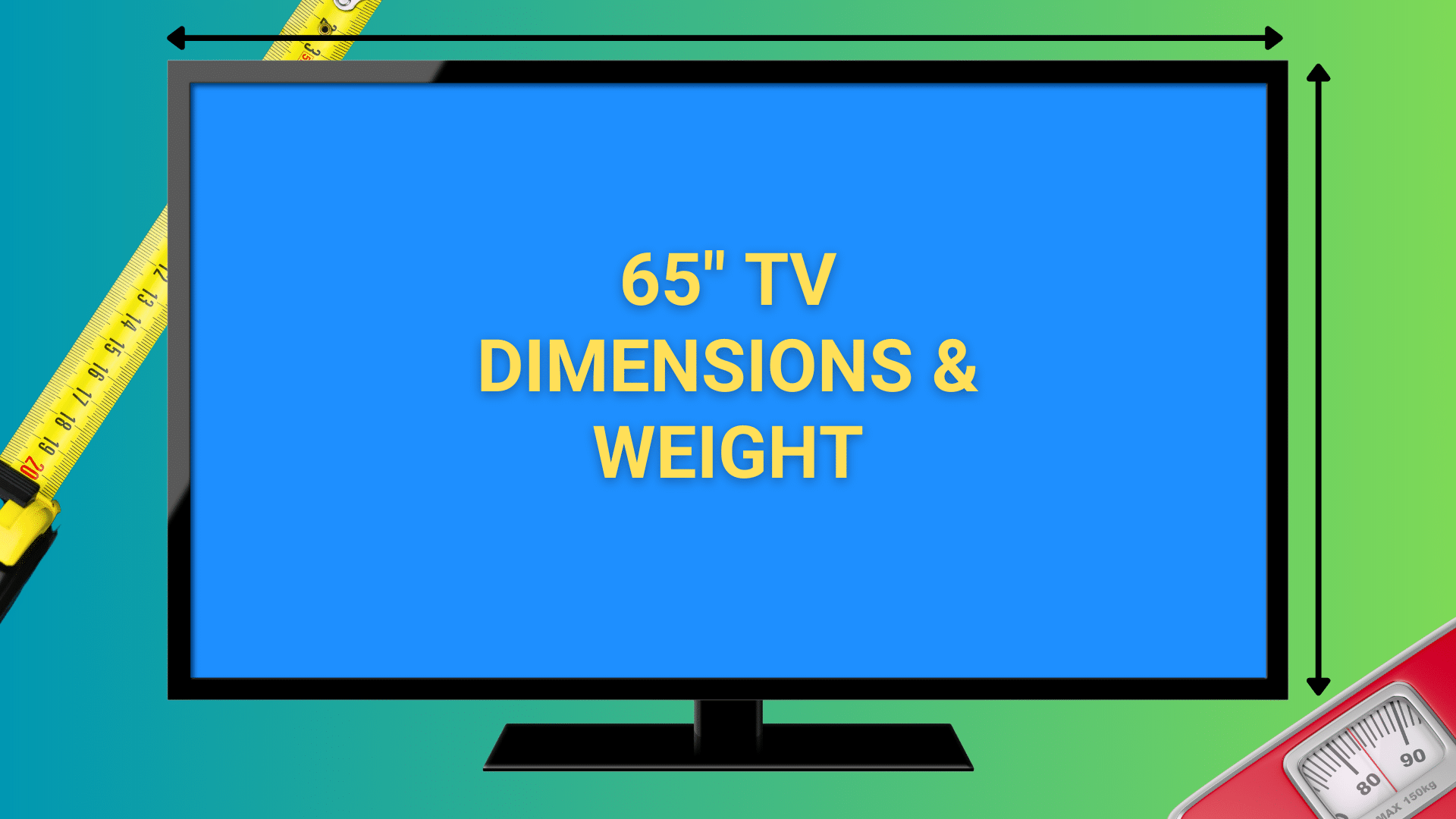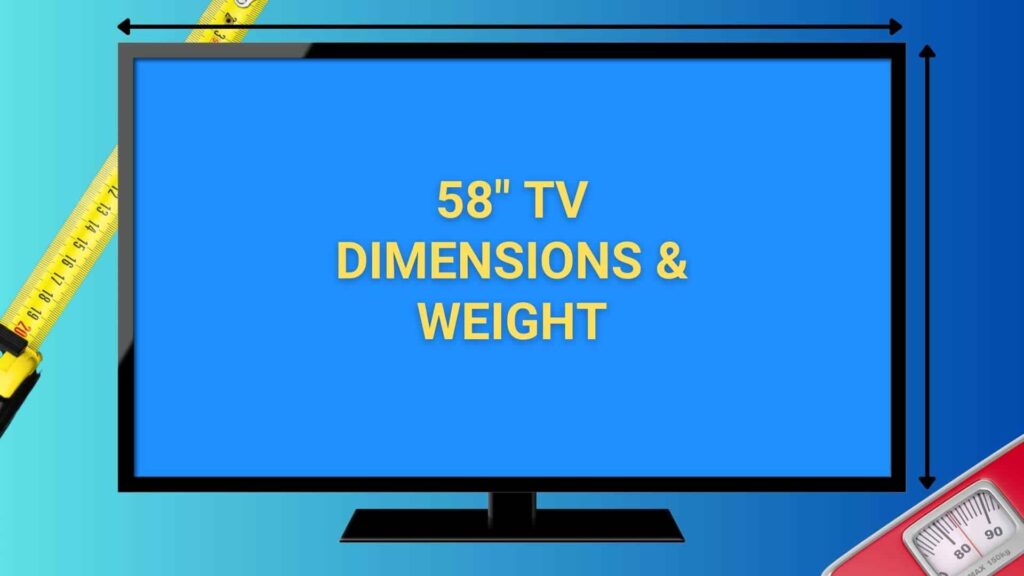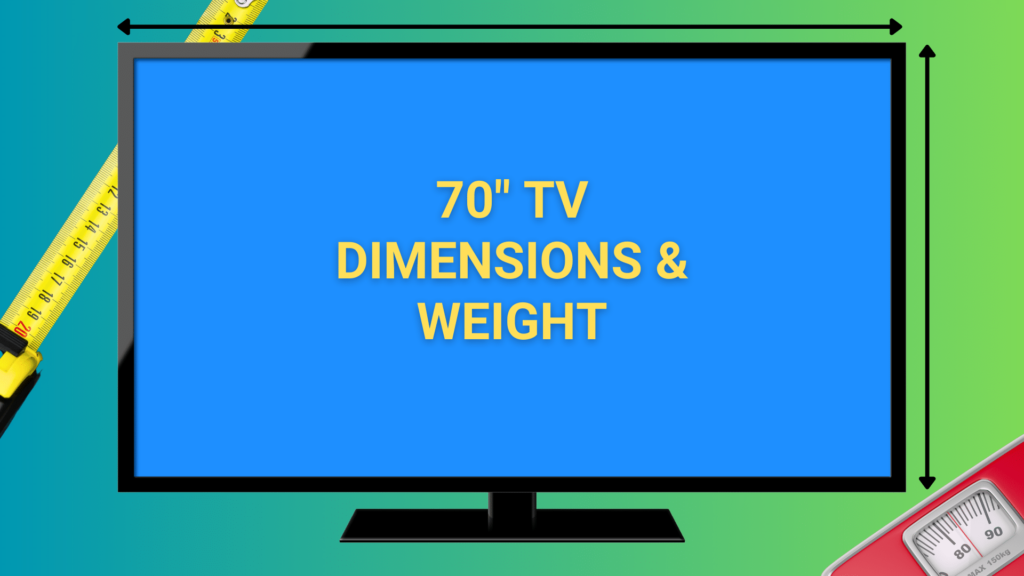Ready to upgrade your living room with a 65 inch TV? Before you make your decision, it’s essential to grasp the particulars of its size and weight.
This comprehensive guide provides you with all the necessary information about the average dimensions, weight, ideal viewing distance, and mounting height for a 65″ TV.
65 Inch TV Size – Average Dimensions
Based on our research of 91 unique models from 8 manufacturers, the average 65 inch TV measures 57.2 inches (145 cm) wide, 32.9 inches (83.6 cm) tall, and 2.5 inches (6.35 cm) deep, including the bezel (frame) around the screen.
The Samsung 65” QN900C Neo QLED 8K TV introduced this year clocks in with the smallest overall size at 56.4 inches (143.3 cm) wide, 32.3 inches (82 cm) tall, and an incredibly thin 0.6 inches (1.5 cm) thick.

Table of Contents
How Wide is a 65 Inch TV? Average 65″ Television Width
The average width of a 65 inch TV including the bezel is 57.2 inches (145 cm).
While the width of the screen itself in a 65″ Class TV stays the same, the overall width of a 65-inch TV can be affected by its bezel size, which varies from model to model.
Thinner bezels can create a more seamless appearance, while thicker bezels may add to the overall width and height. When considering how wide a 65 inch TV is, it’s essential to factor in the overall size of the TV including the bezel.
How Much Does a 65 Inch TV Weigh?
On average, a 65-inch TV weighs 46.7 lbs (21.2 kg) without a stand versus 49.4 lbs (22.4 kg) with a stand.
The weight of a 65 inch TV can vary based on the screen type, size of bezel, and other factors. It’s essential to consider the weight of a TV when planning its installation or mounting, as this can affect the type of mount or support needed to safely secure the television.
Of the 65 inch TVs I researched, I found that the TCL 65″ 4-Series 4K TV weighs in as the lightest at 30.9 lbs (14.0 kg)
Average 65-inch TV Size & Weight Without Stand by Manufacturer
| TV Size & Brand | Unique Models Researched | Average width without stand (inches) | Average height without stand (inches) | Average depth without stand (inches) | Average weight without stand (lbs) |
| 65″ TV Dimensions (Overall) | 91 | 57.2 | 32.9 | 2.5 | 46.7 |
| Hisense | 3 | 57.1 | 32.9 | 2.9 | 38.0 |
| Insignia | 3 | 57.5 | 33.5 | 3.7 | 47.2 |
| LG | 23 | 57.2 | 32.9 | 2.0 | 47.5 |
| Philips | 6 | 57.7 | 33.3 | 3.5 | 32.9 |
| Samsung | 24 | 57.1 | 32.8 | 1.8 | 54.2 |
| TCL | 24 | 57.1 | 32.9 | 3.1 | 44.3 |
| Toshiba | 1 | 57.2 | 32.8 | 2.9 | 36.2 |
| Vizio | 7 | 57.0 | 32.8 | 2.9 | 44.9 |
Average 65″ TV With Stand Sizes & Weights by Manufacturer
| TV Size & Brand | Unique Models Researched | Average width with stand (inch) | Average depth with stand (inch) | Average height with stand (inch) | Average weight with stand (lbs) |
| 65″ TV With Stand Dimensions (Overall) | 91 | 57.1 | 11.4 | 35.0 | 49.4 |
| Hisense | 3 | 57.1 | 12.2 | 35.4 | 38.6 |
| Insignia | 3 | 57.5 | 12.4 | 35.4 | 47.9 |
| LG | 23 | 57.2 | 10.3 | 35.2 | 50.3 |
| Philips | 6 | 57.7 | 11.1 | 35.7 | 33.4 |
| Samsung | 24 | 57.0 | 11.5 | 36.0 | 60.2 |
| TCL | 24 | 57.1 | 12.0 | 33.6 | 45.4 |
| Toshiba | 1 | 57.2 | 12.1 | 35.2 | 37.0 |
| Vizio | 7 | 57.0 | 12.3 | 35.2 | 47.2 |
Related Articles
Best Viewing Distance for a 4k, 65″ TV – Minimum Room Size
To determine the best viewing distance for a 65 inch TV, consider recommendations from THX and SMPTE.
They recommend a viewing distance approximately 8 to 10 feet for 65 inch 4K UHD TVs.
Personal preferences may vary, but it’s essential to find a comfortable distance that suits your needs. The minimum room size for a 65 inch TV should be large enough to accommodate this recommended viewing distance, as well as the TV’s dimensions and any additional furniture.
What is the Best Viewing Distance for an 8K 65″ TV?
Because 8k TVs have a higher resolution, their ideal viewing distance is closer than that of a 4k TV of the same size.
According to a formula provided by THX, an industry leader in movie theater audio technology, the optimal viewing distance for an 8K 65 inch TV is around 4 to 5 feet.
How High Should a 65 Inch TV Be Mounted?
When deciding how high a 65″ TV should be mounted, it’s essential to consider the optimal viewing angle and the recommended viewing distance.
The center of the TV screen should be at eye level when seated, which is typically about 42 inches from the floor for the average viewer.
This height can vary depending on the specific seating arrangement and personal preferences, so it’s crucial to find a mounting height that is comfortable and provides the best viewing experience for your space.
Why Is TV Size Measured Diagonally?
TV size classification is typically measured diagonally from one corner of the screen to the opposite corner. This measurement only includes the screen itself, not the bezel or frame surrounding it.
Measuring screen size diagonally gives us a single number that represents the overall size, making it easy to compare different TVs. The diagonal is the line that goes from one corner of the screen to the opposite corner, and with the aspect ratio (16:9) conveys both the width and the height.
How much bigger is a 65 inch TV vs a 55 inch TV?
A 65 inch TV is approximately 18.2% larger diagonally than a 55 inch TV. In terms of screenarea, a 65-inch TV has roughly 40% more screen space than a 55 inch TV. This difference in size can significantly impact the viewing experience, especially when considering factors such as viewing distance and room size.
Frequently Asked Questions
-
How big is a 65 inch TV in centimeters?
Flat panel TVs in the 65 inch size class measure approximately 165 centimeters diagonally and have an average width of 145.3 cm, height without stand of 83.6 cm, and depth without stand of 6.35 cm.
-
What are the dimensions of a 65 inch Samsung TV?
The dimensions of a 65 inch Samsung TV can vary depending on the specific model. On average, the width is around 57.1 inches (145 cm) and the height is approximately 32.8 inches (83.3 cm) without a stand.
-
Are all 65-inch TVs the same dimensions?
No, 65-inch TVs do not all have the same dimensions. The width, height, and depth can vary depending on the brand, model, and bezel size. However, the screen size (measured diagonally) will remain the same at 65 inches.
-
How big should my TV be if I sit 10 feet away?
If you sit 10 feet (120 inches) away from your TV, a 65-inch TV with a 4K UHD resolution is ideal, as the recommended viewing distance for such TVs is approximately 8 to 10 feet.
-
Does the weight of a TV affect the type of wall mount I need?
Yes, the weight of a TV plays a crucial role in selecting the appropriate wall mount. It is essential to choose a wall mount that can safely support the weight of your TV. Always check the maximum weight capacity of a wall mount before purchasing.
-
How do aspect ratios affect TV dimensions and screen sizes?
Aspect ratios, such as 16:9, represent the relationship between the width and height of a TV screen. And screen-size is the main determining factor in the overall size of a TV including the bezel surrounding the screen.
-
Do TV bezels affect the overall dimensions of a TV?
Yes, TV bezels can affect the overall dimensions of a TV. Thicker bezels may add to the width and height, while thinner bezels can create a more seamless appearance. When considering the dimensions of a TV, it’s important to consider the bezel size.
-
Is there a weight difference between LED, OLED, and QLED Televisions?
Yes, there can be a weight difference between LED, OLED, and QLED TVs.
Generally, OLED TVs tend to be lighter than LED and QLED TVs of the same screen size because they have a thinner panel design and don’t require a backlight.QLED TVs are often slightly heavier than regular LED TVs, as they use additional layers of quantum dots in their panel construction. However, the exact weight difference can vary depending on the brand, model, and additional features of each TV.
Wrap Up
Understanding the dimensions and weight of a 65 inch TV, including its width, height, and depth, is crucial for finding the perfect TV for your space.
The average width of a 65 inch TV is 57.2 inches, with a height of 32.9 inches and an average weight of 46.7 lbs without a stand.
When considering how high a 65″ TV should be mounted, take into account the recommended viewing distance of 8 to 10 feet for a 4K UHD TV, as well as the optimal viewing angle for your seating arrangement.

